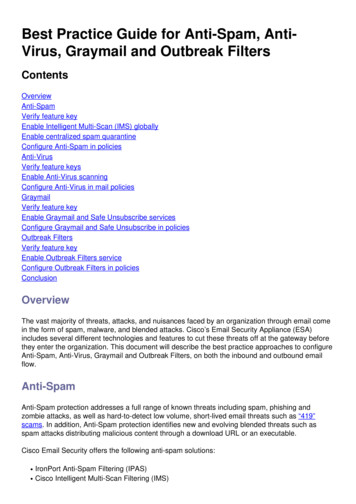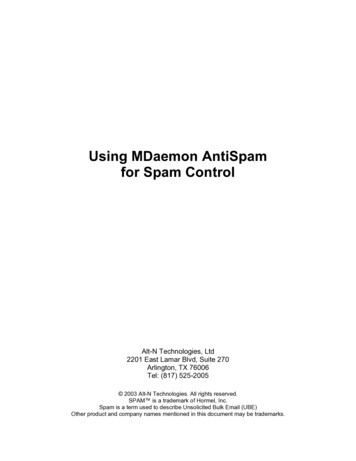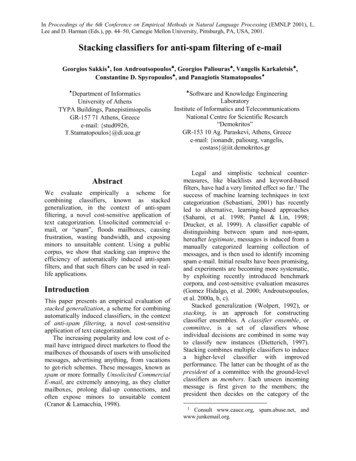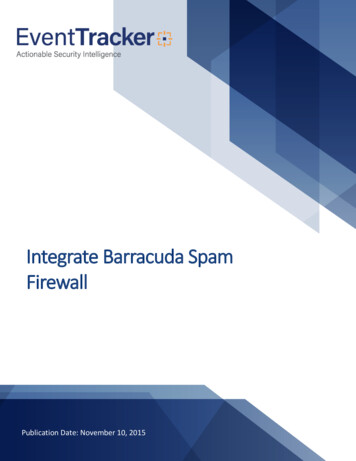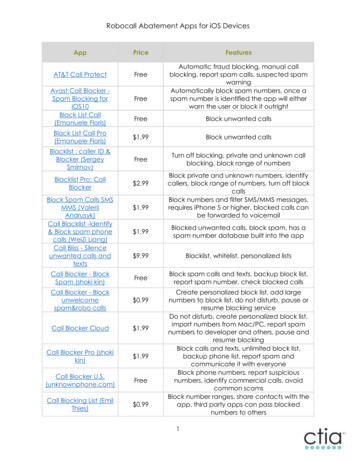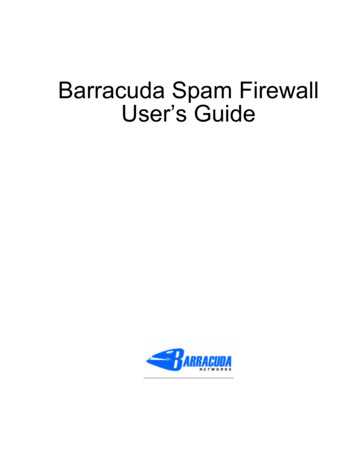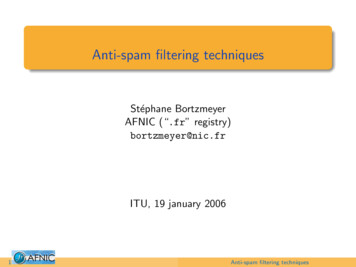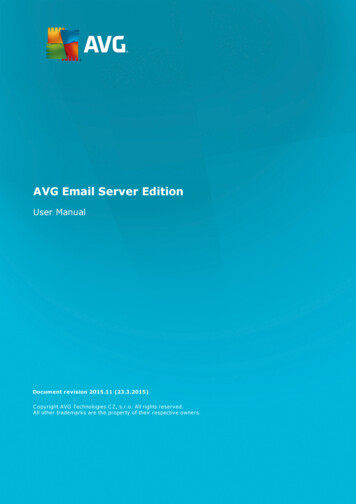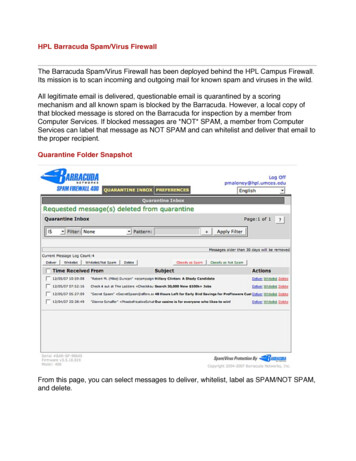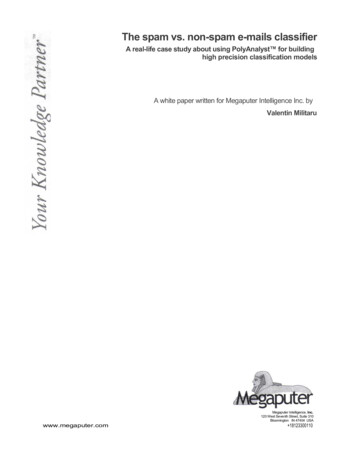
Transcription
The spam vs. non-spam e-mails classifierA real-life case study about using PolyAnalyst for buildinghigh precision classification modelsA white paper written for Megaputer Intelligence Inc. byValentin MilitaruMegaputer Intelligence, Inc.120 West Seventh Street, Suite 310Bloomington IN 47404 USAwww.megaputer.com 18123300110
ContentsGeneral Context and Industry Problem .3Task Definition .3Some Methodological Considerations.4Data Mining: Building the Classification Model.4Data Inspection and Preprocessing .4Algorithm Selection. 6Model Building (Data Mining) . 6Assessment of the Results. 7Conclusions . 7Further Applications . 8Acknowledgements . 9Page 2
The spam vs. non-spam e-mails classifierGeneral Context and Industry ProblemThe case study isbased upon a real-lifeproblem, which waspresented in the DataMining Cup 2003Contest.Isolating spam e-mailsis a matter of criticalimportance in today'scommunicationenvironment.The quality of an emailfilter is basicallydetermined by thequality of itsclassification algorithm.The present case study is based upon a real-life situation, which generated the task forthe Data Mining Cup 2003 Contest (www.data-mining-cup.de) that took place inChemnitz, Germany.1The problem of unrequested received e-mails, most of them with doubtful content, iswell-known. It is estimated that each day, about 25 Mio. of unwelcome emails (socalled spam mails) are sent. This corresponds to 10 percent of all emails worldwide.Performed investigations with the employees of many enterprises turned out that, onaverage, 40 percent of their daily received emails are spam. With some of theemployees, this share reaches up to 90 % of the received e-mails.In spite of corresponding laws, an effective legal prosecution is nearly impossible. Thereceiver faces thus the problem of separating the important emails from the spam mailswhich are often not recognizable at the first sight. Since this is a time-consumingprocess, in the last years, the wish to recognize the spam emails and to select themautomatically has motivated different producers from the software industry to builddedicated applications, equipped with more or less "artificial intelligence", that shouldautomate the classification task. The efficiency of these solutions varies widely and thekey component of any good email filter is its ability to classify emails on the basis ofdifferent measured and synthesized attributes and thus to correctly assign spam andnon-spam emails with a high probability.Task DefinitionStarting from a trainingdataset of 8000 emails,a model for accuratelyclassifying other 11,177mails had to be built.During a program aiming at the optimization of the communication process, themanagement of a medium-size German company observed that an exceedingly largepart of all incoming emails are advertisement mails. The large amount of working timespent by the 120 employees for the daily sorting and final erasure of the spam emailshas unveiled a high potential of rationalization.For this reason, all emails of the company have been collected over some time andstored separately by spam and non-spam emails. Every email was described by a set ofattributes.The accepted errormargin was 1%(misclassified non-spamemails).Finally, al list of the nonspam e-mails shouldhave been delivered.The task was to build a classification model for precisely identifying spam mails. In thisrespect, two datasets were considered:a) a training dataset, containing information about 8,000 e-mails;b) a dataset of 11.177 rows, upon which the classification model should have beenapplied.The objective was to minimize the number of the spam emails which have passed thefilter, subject to the constraint that within the filtered emails only, a maximum of 1%non-spam emails were allowed.As result, a list had to be created, containing the IDs of those emails which have passedthe filter (i.e. all emails which have been recognized as potential non-spam).Page 3
The spam vs. non-spam e-mails classifierSome Methodological ConsiderationsMany data miningtechniquesimplemented byPotyAnalyst could havebeen taken intoconsideration forsolving this task: kNearest Neighbor,Artificial NeuralNetworks, DecisionTrees, etc.With its complex base of data mining engines, Poly Analyst can address a highlydiverse suite of problems. Intuitively, classification tasks can be easily approached withthe Memory Based Reasoning engine, that implements a k-Nearest Neighboralgorithm, or with the Decision Tree/ Decision Forest engines, etc. Nevertheless, it isknown that by data preprocessing, any classification task can be transformed in aprediction task and vice versa. Therefore, one might assume that Stepwise LinearRegression engine or the Artificial Neural Networks engine, that implements thePolyNet Predictor algorithm can be employed too. The logic of selecting theappropriate data mining algorithm is presented later in this whitepaper.Still, an important observation is that the analyst deals with a supervised classificationproblem, therefore cluster-based or association analysis engines are practically uselessfor model building.On the other hand, solving the task imposed the use of both descriptive and predictivedata mining techniques.The project was developed in 4 steps:i) data inspection and preprocessingii) algorithm selectioniii) model building (data mining)iv) assessment of the resultsEach of these steps will be explained in detail further in this material.Data Mining: Building the Classification ModelData Inspection and PreprocessingThe two datasets usedfor training and testingthe model comprisedmore than 16 MillionBoolean variables(19,177x835 16,012,795)Within the Data Mining Cup 2003 Contest, two datasets were provided: the training dataset, containing 8,000 records and the classification dataset, containing 11,177 records (emails) which had to beclassified in spam or non-spam emails.According to the information provided by the organizers of the Data Mining Cup 2003contest, both training and classification data were taken from the same sample and,thus, had the same class distribution. Strictly speaking, all data was taken from asample of a total of 19.177 emails.The structure of both datasets was similar, with the exception of one categorical field(target) which was present only in the training dataset. Values for the target field wereassigned based on past experience (target "yes" - record is spam mail, target "no':—* record is non-spam mail).The two datasets hadan unusually largenumber of attributes.Each record of the training dataset was described by 834 attributes, as follows: the first attribute (id) was numeric and provided the identification number of thecurrent record in the datasetPage 4
The spam vs. non-spam e-mails classifier the last attribute (target) was used to classify the dataset in spam and non-spamrecords the other 832 attributes, all of Boolean type, provided various information about therecords; these descriptive attributes were coded according to those of the popular opensource project Spam Assassin2.Distribution of values for the "id" atribute for both spam and non-spam mailsTraining Dataset Split 0Training Dataset Split 1Note: Only the instances in the Training Dataset were taken into consideration. The graphic clearly shows that thevalue range for the "id" atribute is correlated with the target atribute.PolyAnalyst's SummaryStatistics enginerevealed criticalinformation about theredundant data.An abnormal correlationbetween the ID and thetarget attribute wasrevealed usingPolyAnalyst's chartingcapabilities.The first important information about the data was knowing which attributes werereally relevant for the classification of the records in two categories, namely target "yes" and target "no". For this purpose, the Summary Statistics engine confirmedthat out of 833 Boolean attributes, only 544 were set to "1" at least once in the entiretraining dataset, therefore, only these were providing useful information in theclassification process. The other 289 attributes were constant for all the 8,000 recordsof the training dataset, therefore their respective columns were accounted as redundantdata and were not taken into consideration any further.Another descriptive technique implemented in Poly Analyst revealed an additionalvaluable information about the training dataset. The histogram chart was used forbuilding a view for the distribution of values for the "id" attribute. For a clearerillustration, the training dataset was split into two subsets, one containing only spamemails (target - "yes") and one containing non-spam emails (target "no"). Thegraphic representation revealed a surprising distribution of values: all the recordshaving an id higher than 384140 were spam e-mails (target "yes"). Therefore, the idattribute had to be taken into consideration when building the classification model.These preliminary analyses demonstrated that no data transformation was required;data pre-processing effort was therefore reduced to selecting the attributes withminimum of relevance to the classification process (544 descriptive attributes plus theid field).
The spam vs. non-spam e-mails classifierAlgorithm SelectionAs mentioned before, Poly Analyst offers a powerful base of data mining engines. Yet,the following characteristics of the challenge had to be considered when choosing theappropriate algorithm:the algorithm should have handled very well datasets with large number ofattributesit should have been able to work with both Boolean and numeric attributes it should have been able so find a nonlinear solution the classification model should have been highly precise the algorithm should have taken into consideration all the attributes indicated bythe analyst, since all the 544 1 attributes were identified as relevant in theprevious step.Decision Tree enginewas selected forbuilding theclassification model,due to its high flexibility.According to the above-mentioned requirements, the only algorithm suitable for thedata mining process was Decision Tree. As stated in Poly Analyst's documentation, theDT algorithm is well poised for analyzing very large databases and its calculation timescales very well (grows only linearly) with increasing number of data columns.Although k-Nearest Neighbor might also have looked like a potential solution, itscomputation time is proportional to the square of the number of records. Thus thisalgorithm is not designed for exploring large datasets.Relative to the high number of attributes, it is important to notice that Poly Analyst,unlike other data mining tools, can handle datasets with more than 255 columns. Thisability proved to be vital for this particular application.Model Building (Data Mining)The DT enginegenerated a complexstructure, a 19 levelstree with 48 leaves.The use of the DT algorithm on the training dataset lead to a classification model (tree)with the following characteristics:Number of non-terminal nodes:47Number of leaves:48Depth of constructed tree:19As expected, the DT rule, based on such a large number of attributes, generated a verycomplex tree structure, difficult to represent completely as a graph.In order to verify the accuracy of the model, the DT rule was tested on the trainingdataset (with all the 834 attributes selected), with the following results:First testing of themodel showed anencouraging totalclassification error of0.9%Total classification error:% of undefined prediction cases:Classification probability:Classification efficiency:Classification error for class "Non-spam":Classification error for class "Spam":0.90%0.00%99.10%97.69%0.86%0.96%According to this test, the situation of real vs. predicted cases was satisfactory, only 42out of 4,888 non-spam mails were misclassified (0.86%) and only 30 out of 3,112 spammails were accounted as non-spam (0.96%). The overall test error was therefore72/8,000 cases, that is 0.9%.Page 6
The spam vs. non-spam e-mails classifierConsidering the total error as reasonable (0.9%), the DT rule was applied to theclassification dataset, which lead to the selection of 6753 records (out of 11,177) thatwere regarded as non-spam emails.Assessment of the ResultsTested on theclassification dataset,the model correctlyclassified 6,699 nonspam emails, out of6,803.The evaluation of the model followed a procedure which is typical for every contest.The jury knew which of the 11,177 emails to be classified were actually non-spamemails or spam emails. This information was later available to the participants and thusit became possible the testing of the model against real data.The following table reflects the model's efficiency:Only 104 records wereomitted by theclassification "filter" andonly 54 spam mails"passed" through the"filter".The model offered atotal classification errorof 1.4%Going back to the definition of the task, the project's objective was to minimize thenumber of spam emails which have passed the filter. The actual number of non-spamemails in the classification dataset was 8,803. Only 54 (0.79%) spam mails incorrectlypassed the filter and were misclassified as being non-spam mail. Still, there were 104non-spam mails that the model considered to be spam. In terms of percentage, the modeldid not recognize 1.52% of the non-spam emails.To conclude these calculations, testing the model on the classification dataset provedthat its real precision was of 98.59%, with only 158 misclassified records out of11,177.ConclusionsMost important, this case study adds up evidence about PolyAnalyst's successfulapplication in real-life projects. Its efficiency can be summarized by two aspects: speedand accuracy.The training took 20minutes using a PHIcomputer runningPoly Analyst 4.6 underWin XPAs presented in Megaputer's technical documentation, "Decision Trees isPolyAnalyst's fastest algorithm when dealing with a large amount of records and/orfields". Running on a Pentium III at 650 MHz with only 64 MB of RAM, theclassification model took less than 1 hour to build with a demo version of PolyAnalyst4.5 under Windows 98. Using the same 8,000 records dataset, but this time on aPentium III at 650 MHz with 128 MB of RAM, the time was reduced at 20 minutes, fora licensed version of PolyAnalyst 4.6, under Windows XP. Applying the model on the11,177 rows dataset was only a matter of seconds.Page 7
The spam vs. non-spam e-mails classifierThe model offered aclassification error farbetter than most of thesolutions that weresubmitted in the DMC2003 contest.As regards the accuracy of the model, Poly Analyst's decision tree algorithm proved itscapacity to build high precision classification models. From a dataset of 11,177records, only 158 were misclassified, which represents a global error of than 1.4%.Such level of precision is critical in some areas of application (such as medicine) and ahuge advantage in others, like finance or CRM.Yet, a third aspect deserves to be mentioned in our conclusion: the software's ability tohandle large volumes of data. This characteristic was critical in our example, since thetraining dataset contained more than 6.6 Mil Boolean records and the total size of theproject reached 16 Mil Boolean records (835 columns x 19,177 rows).Further ApplicationsSame classificationapproach can beapplied in fields likemarketing, retailanalyses, frauddetection, finance, etc.Such data analysis model can be further replicated in many other areas of interest.Classification tasks are widely encountered in data mining projects, some of the mostcommon fields being:Customer Relationship Management: which prospects are most likely to respondto a new promotion or which customers are about to switch to a competitor?Fraud detection: which transactions are most likely to be fraudulent?Retail/point-of-sales analyses: which location is most appropriate for a future store?Portfolio analysis: which securities/ assets would fit a predefined portfolio at a certainpoint in time?Medicine: what diagnostic or medication is suitable for a complex of symptoms?Page 8
The spam vs. non-spam e-mails classifierAcknowledgementsThe author wishes to thank Mr. Richard Kasprzycki and Mr. Hrishikesh Pore fromMegaputer Intelligence Inc for their confidence and invaluable contribution to thewriting of this material. Also, the author congratulates the organizers of the DMC 2003contest and thanks Mrs. Sandra HOmke and Mr. Jens Scholz from Prudsys A.G. fortheir acceptance to further using the data provided in the contest.Notes:' The Data Mining Cup contest (www.data-mining-cup.de) is a competition that is organized every yearat Chemnitz, Germany, by the Chemnitz University of Technology (www.tu-chemnitz.de), Prudsys AG(www.prudsvs.de) and the European Knowledge Discovery Network of Excellence (www.kdnet.org).The contest is addressed to students of universities, advanced technical colleges as well as universitiesof cooperative education from Germany and abroad.In 2003 there were 514 registered participants, from 199 universities and colleges around the world (39countries), out of which only 156 found a solution to the problem.2SpamAssassin(tm) is a mail filter to identify spam. Using its rule base, it uses a wide range of heuristictests on mail headers and body text to identify unsolicited commercial email. For more information seehttp://spamassassin.orgPage 9
Author: Militant, Valentin-DragosFaculty of Cybernetics, Statistics and Computer ScienceAcademy of Economic Studies, BucharestTEL: 40.744.689.080EMAIL: valentin.militaru@home.roCorporate and Americas HeadquartersMegaputer Intelligence, Inc.120 West Seventh Street, Suite 310Bloomington, IN 47404, USATEL: 1.812.330.0110; FAX: 1.812.330.0150EMAIL: info@megaputer.comEurope HeadquartersMegaputer Intelligence, Ltd.B. Tatarskaja 38Moscow 113184, RussiaTEL: 7.095.951.8079; FAX: 7.095.953.5731EMAIL: info@megaputer.comCopyright 2003 Megaputer Intelligence, Inc.All rights reserved. Limited copies may be made for internal use only. Credit must be givento the publisher. Otherwise, no part of this publication may be reproduced without priorwritten permission of the publisher. PolyAnalyst and PolyAnalyst COM are trademarks ofMegaputer Intelligence Inc. Other brand and product names are registered trademarks oftheir respective owners.
The spam vs. non-spam e-mails classifier the last attribute (target) was used to classify the dataset in spam and non-spam records the other 832 attributes, all of Boolean type, provided various information about the records; these descriptive attributes were coded according to those of the popular open- source project Spam Assassin2.


